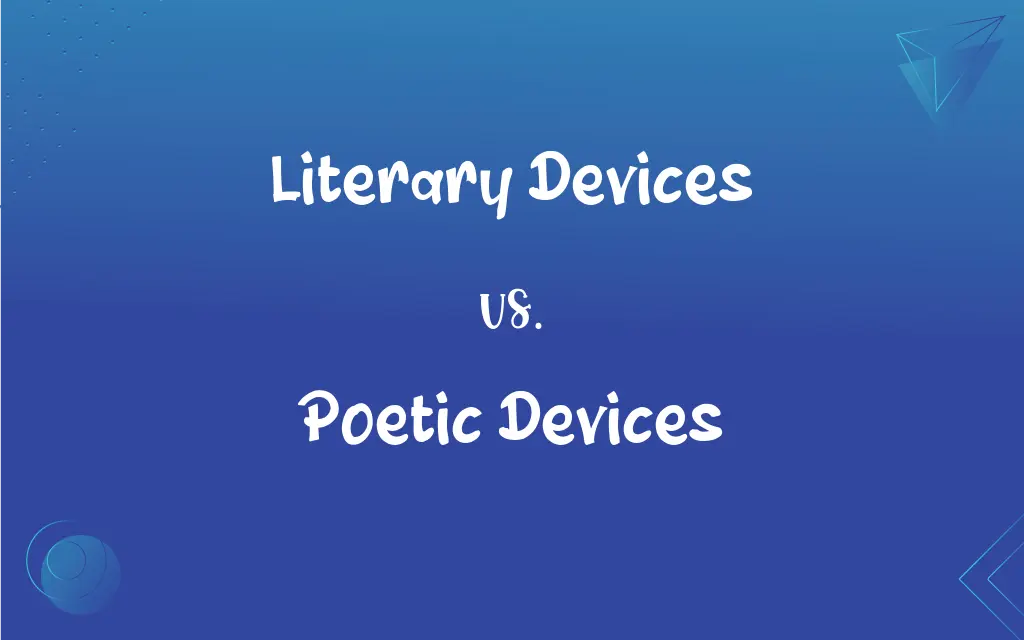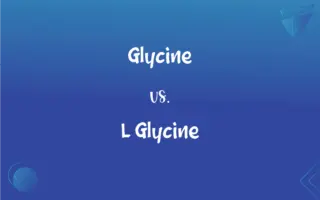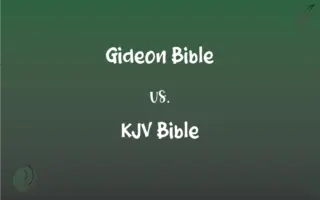Literary Devices vs. Poetic Devices: What's the Difference?
Edited by Aimie Carlson || By Janet White || Published on February 21, 2024
Literary devices are techniques used in writing to convey ideas and enhance narrative; poetic devices are specifically used in poetry to create rhythm, imagery, and emotional response.

Key Differences
Literary devices encompass a broad range of techniques used across different forms of writing, including fiction, non-fiction, and drama, to enhance the narrative, develop characters, or create themes. Poetic devices, while a subset of literary devices, are specifically employed in poetry to enhance its musicality, emotional appeal, and visual imagery.
Literary devices include metaphor, symbolism, foreshadowing, and narrative perspective, which serve various purposes like creating depth and meaning. Poetic devices such as rhyme, meter, assonance, and alliteration are geared towards augmenting the poem's rhythm, sound, and overall aesthetic.
Literary devices are used across various genres of literature to add complexity and depth, while poetic devices are tailored to the unique structure and form of poetry, focusing on conciseness, sound patterns, and imagery.
Literary devices are tools for storytelling, shaping narrative and character development. In contrast, poetic devices often focus on creating an immersive sensory experience, playing with language rhythmically and visually to evoke emotions and imagery.
Literary devices shape the reader's experience by adding layers of meaning, enhancing themes, or providing insights into characters. Poetic devices, specifically, influence how a poem feels and sounds, contributing to its mood, tone, and pace.
ADVERTISEMENT
Comparison Chart
Scope and Usage
Used in various forms of literature
Specifically used in poetry
Techniques
Metaphor, symbolism, foreshadowing
Rhyme, meter, assonance, alliteration
Genre Application
Across fiction, non-fiction, drama
Tailored to poetry's structure and form
Function and Purpose
Enhance narrative, character development
Enhance rhythm, sound, and imagery
Impact on Reader
Add depth and meaning
Create sensory experience, evoke emotions
ADVERTISEMENT
Literary Devices and Poetic Devices Definitions
Literary Devices
Symbolism is a literary device where objects represent larger concepts.
The dove symbolizes peace in the narrative.
Poetic Devices
Alliteration is the repetition of consonant sounds at word beginnings.
She sells seashells by the seashore.
Literary Devices
Metaphor is a literary device that compares two unlike things directly.
Time is a thief that steals our moments.
Poetic Devices
Enjambment is a poetic device where a sentence continues beyond a line.
The river meanders, cold and deep, under the moon, a secret it keeps.
Literary Devices
Allusion is a literary device referencing a person, place, or event.
He was a real Romeo with the ladies.
Poetic Devices
Rhyme is a poetic device where similar sounds end different lines.
The star, so far, shone from afar.
Literary Devices
Foreshadowing is a literary device that hints at future events in a story.
The gathering storm clouds foreshadowed trouble ahead.
Poetic Devices
Meter is a poetic device that gives poetry a rhythmic structure.
The iambic pentameter gives a steady beat to the poem.
Literary Devices
Irony is a literary device where the meaning is opposite to the words.
What a pleasant day! he exclaimed in the pouring rain.
Poetic Devices
Assonance is the repetition of vowel sounds in nearby words.
The light of the night made a delightful sight.
FAQs
Can literary devices be used in poetry?
Yes, many literary devices like metaphor and symbolism are also used in poetry.
What are poetic devices?
Poetic devices are specific techniques used in poetry to enhance rhythm, imagery, and emotional impact.
How does metaphor function in literature?
Metaphor compares two unlike things to add depth and understanding to literary work.
What role does foreshadowing play in storytelling?
Foreshadowing hints at future events, creating suspense and continuity in the narrative.
What are literary devices?
Literary devices are techniques used by writers to enhance their narrative and convey deeper meanings.
Are literary devices important in non-fiction?
Yes, they can add depth and interest to non-fiction writing as well.
Is assonance common in all poetry?
Assonance is common but not present in all poems, depending on the poet’s style.
Can alliteration be used outside of poetry?
Yes, alliteration is used in prose to create emphasis or aesthetic pleasure.
Is rhyme only a poetic device?
Primarily, though rhyme can occasionally be used in other forms of writing for effect.
What is the purpose of meter in poetry?
Meter provides a rhythmic structure, making poetry more musical and rhythmic.
How does symbolism contribute to literary works?
Symbolism adds layers of meaning, allowing readers to find deeper significance in the narrative.
Is allusion used frequently in literature?
Allusion is commonly used to add depth by referencing other works, events, or figures.
Can irony be effective in poetry?
Yes, irony can add a layer of complexity and depth to poetry.
How does rhyme enhance a poem?
Rhyme adds musicality and helps to establish a rhythm in the poem.
Can literary devices change reader’s perspectives?
Yes, they can offer new insights and angles on a narrative or theme.
Do literary devices help in character development?
Yes, they can reveal character traits and complexities.
What’s the difference between metaphor and simile?
A metaphor is a direct comparison, while a simile uses “like” or “as” for comparison.
Are poetic devices only relevant to traditional poetry?
Poetic devices are relevant to all forms of poetry, including modern and free verse.
Is understanding poetic devices important for readers?
Understanding these devices can enhance the reader’s appreciation and interpretation of poetry.
What makes enjambment a unique poetic device?
Enjambment creates a flow that transcends lines, enhancing the poem’s rhythm and continuity.
About Author
Written by
Janet WhiteJanet White has been an esteemed writer and blogger for Difference Wiki. Holding a Master's degree in Science and Medical Journalism from the prestigious Boston University, she has consistently demonstrated her expertise and passion for her field. When she's not immersed in her work, Janet relishes her time exercising, delving into a good book, and cherishing moments with friends and family.
Edited by
Aimie CarlsonAimie Carlson, holding a master's degree in English literature, is a fervent English language enthusiast. She lends her writing talents to Difference Wiki, a prominent website that specializes in comparisons, offering readers insightful analyses that both captivate and inform.
































































